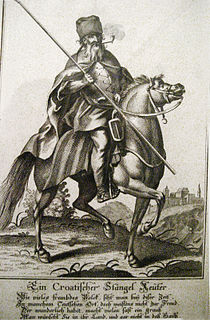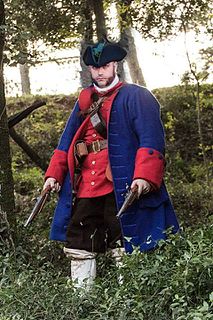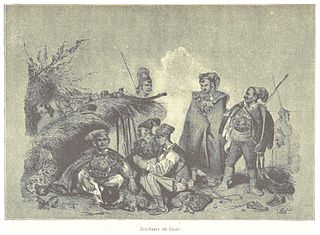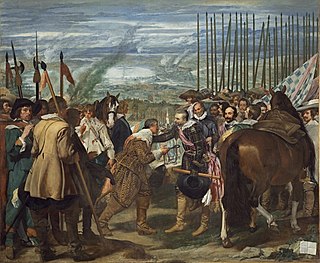 W
WBandes d'ordonnance (French) or Benden van ordonnantie (Dutch) were elite heavy cavalry formations recruited from the aristocracy in the early-modern Low Countries. They were originally formed by Charles the Bold, Duke of Burgundy, and became an integral part of the military organization of the Low Countries from the mid-fifteenth to late-sixteenth centuries, up to the first years of the Eighty Years' War. They continued to exist into the seventeenth century with far less military importance, although a command in a Bande d'ordonnance was still a considerable social distinction.
 W
WThe Croats, also known as Cravats or Crabats were 17th-century light cavalry forces in Central Europe, comparable to the hussars. The Croats were initially irregular units loosely organized in bands. The first regular Croat regiment was established in 1625.
 W
WCuirassiers were cavalry equipped with a cuirass, sword, and firearm(s), first appearing in late 15th-century Europe. The first cuirassiers were produced as a result of armoured cavalry, such as the men-at-arms and demi-lancers, discarding their lances and adopting the use of pistols as their primary weapon. In the later 17th century, the cuirassier lost his limb armour and subsequently employed only the cuirass, and sometimes a helmet. By this time, the sword or sabre had become their primary weapon, pistols being relegated to a secondary function.
 W
WThe "Demi-lancer" or demilancer was a type of heavy cavalryman found in Western Europe in the 16th and early 17th centuries.
 W
WThe Dutch States Army was the army of the Dutch Republic. It was usually called this, because it was formally the army of the States-General of the Netherlands, the sovereign power of that federal republic. This mercenary army was brought to such a size and state of readiness that it was able to hold its own against the armies of the major European powers of the extended 17th century, Habsburg Spain and the France of Louis XIV, despite the fact that these powers possessed far larger military resources than the Republic. It played a major role in the Eighty Years' War and in the wars of the Grand Alliance with France after 1672.
 W
WAn exercitiegenootschap or militia was a military organisation in the 18th century Netherlands, in the form of an armed private organization with a democratically chosen administration, aiming to train the citizens and the lower bourgeoisie in use of muskets. Exercitiegenootschappen were propagated by Joan van der Capellen tot den Pol, who translated an old book (1732) by Andrew Fletcher on arming a nation's citizens and so got the idea from Scotland. He also saw them as necessary due to the serious decline in the existing, Orangist schutterijen.
 W
WThe Garde Écossaise was an elite Scottish military unit founded in 1418 by the Valois Charles VII of France, to be personal bodyguards to the French monarchy. They were assimilated into the Maison du Roi and later formed the first company of the Garde du Corps du Roi.
 W
WThe harquebusier was the most common form of cavalry found throughout Western Europe during the early and mid 17th century. Early harquebusiers were characterised by the use of a form of carbine, called a "harquebus". In England, harquebusier was the technical name for this type of cavalry, though in everyday usage they were usually simply called 'cavalry' or 'horse'. In Germany they were often termed Ringerpferd, or sometimes Reiter, in Sweden they were called lätta ryttare.
 W
WLine infantry was the type of infantry that composed the basis of European land armies from the middle of the 17th century to the middle of the 19th century. Maurice of Nassau and Gustavus Adolphus are generally regarded as its pioneers, while Turenne and Montecuccoli are closely associated with the post-1648 development of linear infantry tactics. For both battle and parade drill, it consisted of two to four ranks of foot soldiers drawn up side by side in rigid alignment, and thereby maximizing the effect of their firepower. By extension, the term came to be applied to the regular regiments "of the line" as opposed to light infantry, skirmishers, militia, support personnel, plus some other special categories of infantry not focused on heavy front line combat.
 W
WA man-at-arms was a soldier of the High Medieval to Renaissance periods who was typically well-versed in the use of arms and served as a fully armoured heavy cavalryman. A man-at-arms could be a knight or nobleman, a member of a knight or nobleman's retinue or a mercenary in a company under a mercenary captain. Such men could serve for pay or through a feudal obligation. The terms knight and man-at-arms are often used interchangeably, but while all knights equipped for war certainly were men-at-arms, not all men-at-arms were knights.
 W
WMiquelets or Micalets were irregular Catalan and Valencian mountain light troops. They enjoyed a certain prominence in the wars in the Iberian Peninsula during the 17th and 18th centuries, and in peace seem to have on occasion plundered travellers.
 W
WA musketeer was a type of soldier equipped with a musket. Musketeers were an important part of early modern armies, particularly in Europe, as they normally comprised the majority of their infantry. The musketeer was a precursor to the rifleman. Muskets were replaced by rifles in most western armies during the mid-1850s. The traditional designation of "musketeer" for an infantry private survived in the Imperial German Army until World War I.
 W
WReiter or Schwarze Reiter were a type of cavalry in 16th to 17th century Central Europe including Holy Roman Empire, Polish-Lithuanian Commonwealth, Tsardom of Russia, and others.
 W
WThe Royal Sardinian Army was the army of the Duchy of Savoy and then of the Kingdom of Sardinia, which was active from 1416 until it became the Royal Italian Army on 4 May 1861.
 W
WThe Serbian Free Corps, known simply as frajkori, was a volunteer militia composed of ethnic Serbs, established by the Habsburg Monarchy, to fight the Ottoman Empire during the Austro-Turkish War (1787–91). The conflict with Turkish forces ultimately proved inconclusive. The rebellion in the Sanjak of Smederevo and militia's operations resulted in the period of Habsburg-occupied Serbia, which took place from 1788 to 1792. Ultimately, the Serbian volunteer corps had the legacy of promoting the creation of future paramilitaries, such as during the First Serbian Uprising.
 W
WThe Seressaner were an Habsburg military police unit in Lika, Croatian Military Frontier. The name is derived from Saracens.
 W
WTelegraph troops are responsible for the establishment of their own side’s telegraphic communications in war and for the disruption of the enemy’s telegraphic communications. The telegraph troops created in Prussia in 1830 within the New Prussian engineer battalions were established as a separate corps in 1899, which subsequently became the Signal Corps of the Wehrmacht and Waffen SS. Its modern successors are the signal troops and electronic warfare troops. Its predecessors used various optical telegraphic systems.
 W
WA tercio or tercio español was a type of Spanish pike and shot infantry unit known for its numerous victories on the battlefields of Europe during the 16th century and the first half of the 17th century, and was a major development of early modern combined arms warfare.